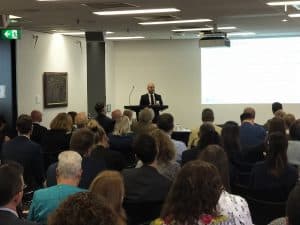 Below is the list of occupational health and safety (OHS) issues for the next three years, put to the Australian Council of Trade Unions and passed, at its Congress on 18 July 2018. Some were expected but others will cause concern, primarily, for business owners. Perhaps the major concern is that these commitments are to be rolled out nationally.
Below is the list of occupational health and safety (OHS) issues for the next three years, put to the Australian Council of Trade Unions and passed, at its Congress on 18 July 2018. Some were expected but others will cause concern, primarily, for business owners. Perhaps the major concern is that these commitments are to be rolled out nationally.
Category: insurance
Talking about OHS could remove the need for Industrial Manslaughter laws
Gaby Grammeno has been writing about workplace health and safety (WHS) issues for longer than I have. Her work for Workplace OHS, a subscription OHS news service, includes an “ask an expert” service and her latest is a comparison between the OHS/WHS laws involving “reckless endangerment” and “industrial manslaughter”.
The article is of interest to OHS people and reinforces some of the legal opinions on the proposed introduction of industrial manslaughter laws in Victoria. There is disparity in sentencing and financial penalties in Queensland laws compared to potential Victorian ones and one includes “serious injuries” where the other addresses deaths. But the issue of penalty sizes is a sideshow to the intended purpose of these types of laws – deterrence.
Will a penalty of A$3.8 million have a greater deterrent effect than A$3.1 million?
We need a safe system of business
 Throwing chocolates to delegates, audience participation, push-ups, book giveaways, hand-eye coordination exercises – not the usual elements of the opening keynote speaker of a safety conference. Day 2 of the Safety Institute of Australia’s recent conference had a more traditional opening with presentations from a State workplace safety regulator and Australia’s occupational health and safety (OHS) agency. If entertainment is your thing, jump for the chocolates, but if information is why you attend conferences, Day 2 was the better one.
Throwing chocolates to delegates, audience participation, push-ups, book giveaways, hand-eye coordination exercises – not the usual elements of the opening keynote speaker of a safety conference. Day 2 of the Safety Institute of Australia’s recent conference had a more traditional opening with presentations from a State workplace safety regulator and Australia’s occupational health and safety (OHS) agency. If entertainment is your thing, jump for the chocolates, but if information is why you attend conferences, Day 2 was the better one.
The first speaker was
Michalak’s evidence should change the wellbeing and OHS industries
 Dr Rebecca Michalak has only recently come to my attention, mainly through challenging some of my statements on social media. I was able to meet her and watch her presentation at the Safety Institute of Australia’s National Health and Safety Conference in May 2018. It is likely her voice will become heard more broadly in coming years as she challenges elements of the Establishment.
Dr Rebecca Michalak has only recently come to my attention, mainly through challenging some of my statements on social media. I was able to meet her and watch her presentation at the Safety Institute of Australia’s National Health and Safety Conference in May 2018. It is likely her voice will become heard more broadly in coming years as she challenges elements of the Establishment.
Many elements of Michalak’s conference presentation can also be heard in the Fit For Work Podcast of Sally McMahon but there were a couple of statements that were notable.
Coping Strategies
“I had a theory that it’s not either/or – it’s an “it depends” thing and what I found across all well-being outcomes, six coping strategies and two samples – that’s 48 mediations – it makes no difference and in fact, most coping strategies make well-being worse.” (emphasis added)
Industrial Manslaughter laws likely for Victoria
 With little surprise, at the Australian Labor Party (ALP) Conference in Victoria on 26 May 2018, Premier Daniel Andrews has included the introduction of Industrial Manslaughter laws as a formal part of the campaign for re-election in November 2018.
With little surprise, at the Australian Labor Party (ALP) Conference in Victoria on 26 May 2018, Premier Daniel Andrews has included the introduction of Industrial Manslaughter laws as a formal part of the campaign for re-election in November 2018.
According to his media release, if re-elected,
“.., employers will face fines of almost $16 million and individuals responsible for negligently causing death will be held to account and face up to 20 years in jail.
A re-elected Andrews Labor Government will make sure all Victorians are safe in our workplaces, with the offence to also apply when an employer’s negligent conduct causes the death of an innocent member of the public..”
There are a lot of steps between an incident and Industrial Manslaughter charges.
Why are we arguing about Industrial Manslaughter laws?

On the issue of Industrial Manslaughter laws, Lana Cormie (pictured far right) said:
“Employers need to have motivation to do the right thing, ’cause clearly they don’t do it off their own back. So, if that means, if this’ll be the difference between them making OH&S a high priority and not, then it needs to be done. And I think all the other benefits for the men on the ground, and the women on the ground, will filter down from that. “
Her comments on International Workers Memorial Day emphasises that the introduction of these laws is not so much about new laws but the failure of the existing ones and of their application. Over time, the general commitment to implementing occupational health and safety (OHS) has declined in many workplaces or, at least, has not progressed in the way expected by the safety law makers of the 1970s and 1980s.
Government has relied on the increase of financial penalties as the major deterrent Continue reading “Why are we arguing about Industrial Manslaughter laws?”
Safety insights from Return-To-Work Forum
 A lot of statistics were presented at a workers’ compensation research seminar in Melbourne on 1 March 2018. Monash University’s Insurance Work and Health Group provided a useful perspective on return-to-work matters with several points relevant to occupational health and safety (OHS).
A lot of statistics were presented at a workers’ compensation research seminar in Melbourne on 1 March 2018. Monash University’s Insurance Work and Health Group provided a useful perspective on return-to-work matters with several points relevant to occupational health and safety (OHS).
Both Professor
